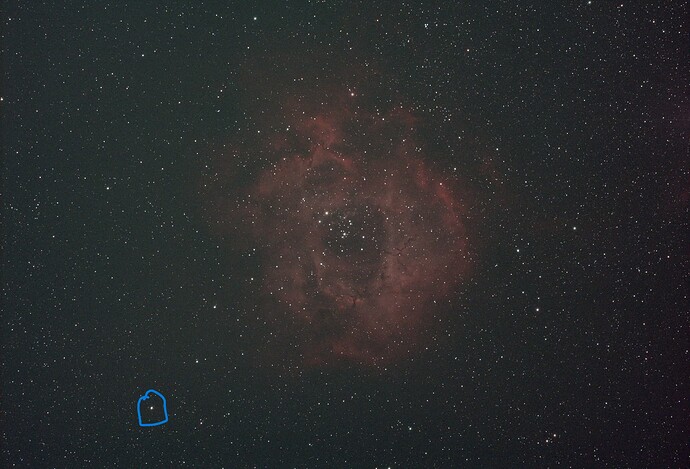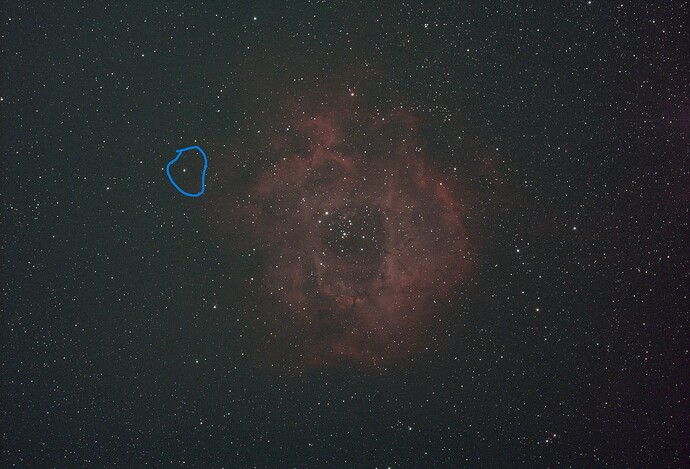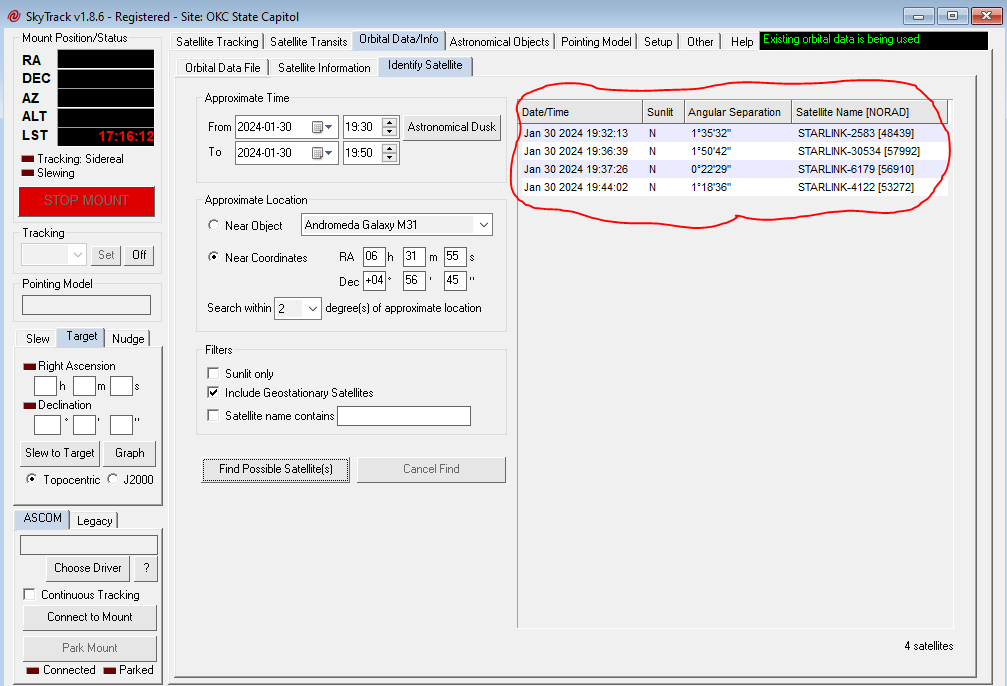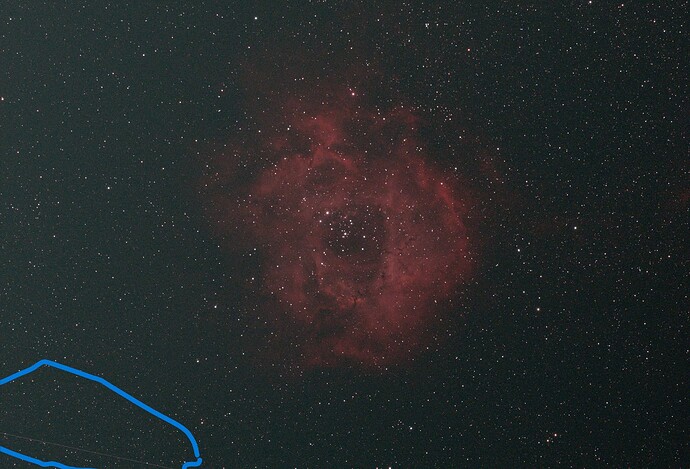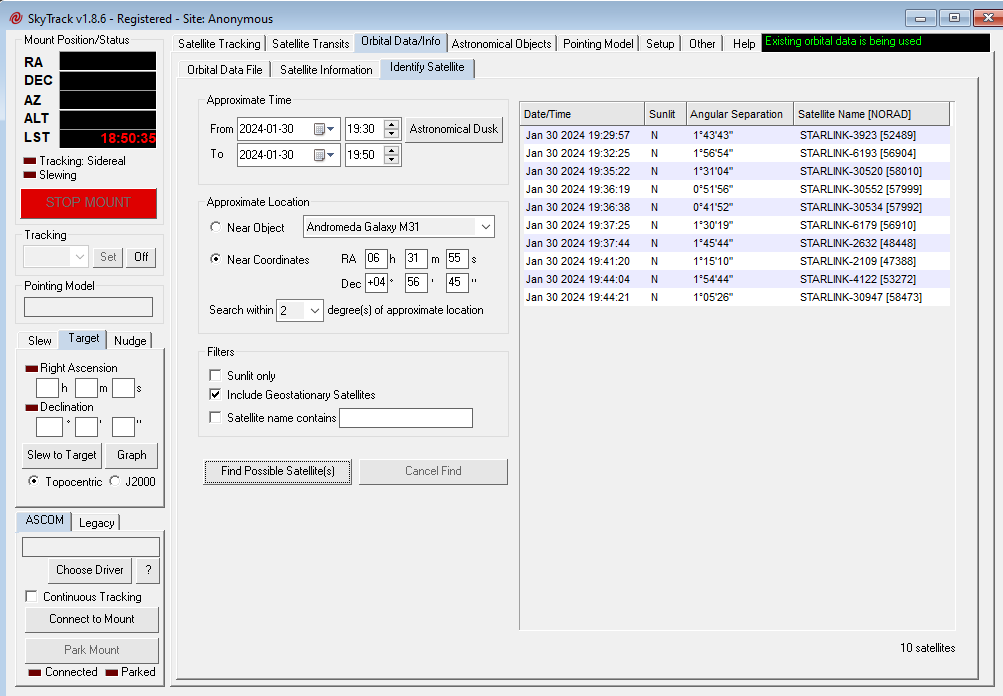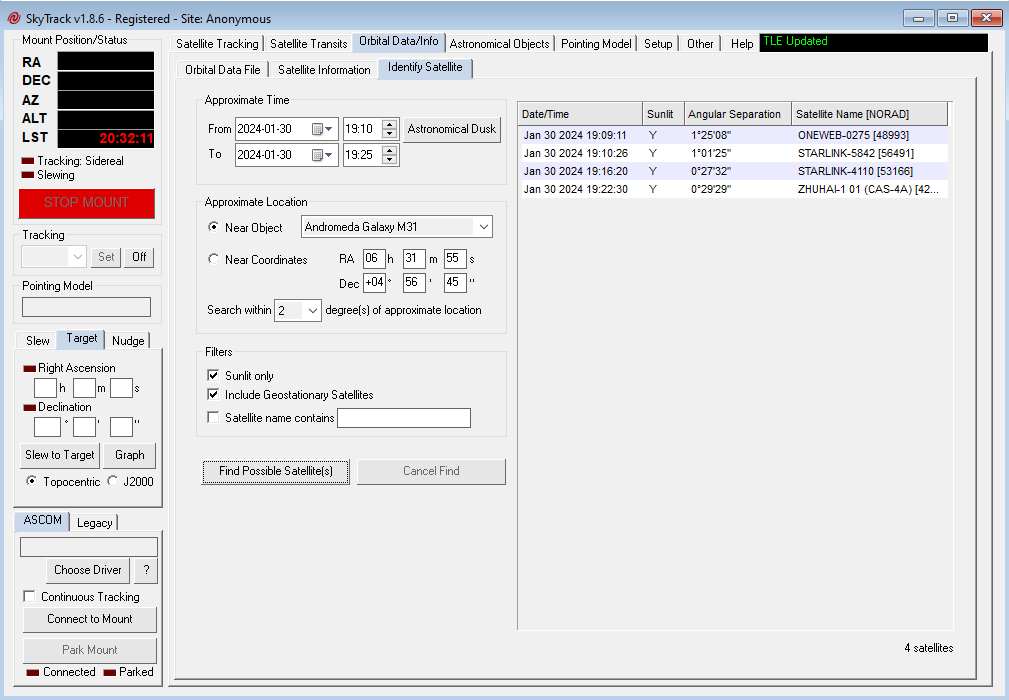Last night during my imaging session of the Rosette, I captured an unknow object, it is in 2 of my 5 minute subs. I checked Stellarium and was unable to identify the object. Can anyone help? I have the raw images with all the FITS data if needed.
Clear Skies!
Richard
This will be interesting to see the results of, wishing I was the caliber of individual that could help in the discovery of it.
I agree with Joel, this will be interesting. I checked bright asteroids and none were this close to the Rosette at the time of these subs. Plus taking 5 minute subs it would show a little elongation versus the surrounding stars. But in these 2 subs taken at 7:35 and 7:40 the object does not show noticable elongation but moves almost the entire length of the Rosette.
I didn’t see a time when these were taken. This was on Jan 30th at what time?
Dave,
The file names for the images appear to contain date and time info:
Image 1: January 30, 2024 at 19:35:06
Image 2: January 30, 2024 at 19:40:07
I assume these are local dates and Central Standard Time.
It is not clear if the times are mid capture, start of capture, or end of capture.
The times are local CST, images were taken in Edmond from my backyard.
telescope 335mm focal length, 71mm aperture.
camera ASI294MC PRO * Resolution: 10.7 Mega Pixels (4144 X 2822)
- Pixel Size: 4.63µm
as far as the timestamp, I would assume it is placed at the end of the exposure. So start times for the pictures would be.
- 19:30 CST
- 19:35 CST
I’ve the images thru Siril plate solver it did not identify the object either.
Also was using a L-enhance dual narrowband filter, Ha & Oiii
I plate solved your images at astrometry.net and found the image center to be at:
RA: 06h 31m 54.880s Dec: +04° 56’ 44.839"
The field of view is: 3.28 x 2.23 deg. The image scale is 17.1 arcsec per pixel.
With this information, the date/time info in each image’s file name, and the measured pixel movement of the object, it appears the object was moving between 410-821 arcsec/minute (depending on whether your times are mid-capture, start of capture, or end of capture). This movement is way too fast for an asteroid. Consequently, assuming the object was not a meteor, pair of random hot pixels, or random cosmic ray hits, in my view, the next most likely candidate is a satellite (I also considered an aircraft, but feel that is unlikely for several reasons).
Bracketing the times of your images as being between 19:30 and 19:50 CST on January 30th, and not knowing your exact location, I entered the following into SkyTrack to identify any satellites that may have flown within 2 degrees of the center of your images:
From: 2024-01-30 19:30
To: 2024-01-30 19:50
Location: 35.49247792875747, -97.50307124784537
(I didn’t know your location so chose the coordinates of the State Capitol in downtown OKC. To obtain an accurate result, very precise location info for the observer’s location is required because of parallax. )
Sky Track listed the candidate satellites shown in the screenshot below. All are STARLINK satellites. Probably one of these four.
I am a bit puzzled, however, as to why the object(s) left no trail/streak in your images. Moving as fast as they were, the object(s) should have left a trail across your 5-minute exposures. I am going to guess that either your image capture or post-processing software filters out moving targets like satellites to remove their trails from your images. I’m going to guess further that the object pixels that remain in your images represent the initial detection of the object before it met the minimum movement threshold of the moving pixel removal function of your capture/processing software.
Anyhow, this is my guess as to what the moving object is in your images. This is just a guess. I’m certainly open to other possibilities.
Russ,
Thanks for the info, I was hoping you would chime in! The software that I use does not discard any images. images with satellites do leave streaks (included example from last night). There is only an auto stretch applied to the raw image. when left in linear you can still see the object in the sub. I tend to think satellites also but…
Thanks!
Richard
Richard,
Now I am really scratching my head. No trailing leads me back to random cosmic ray hits. But, without getting into a long-winded explanation, I can envision a scenario in which a satellite leaves a single point rather than a streak, so satellite is still an option.
Oh, I just received a private message from you. I’ll check it now.
Russ
Richard,
I just ran SkyTrack again using the location coordinates you sent by PM. It looks like a STARLINK satellite is still a possibility, but the candidate list is now longer (see screenshot below).
I am still bothered by no trailing in the images, but perhaps the geometry of the Sun’s position, the satellite(s) position, and the Earth’s shadow only permitted a brief flash, not a continuously sunlit satellite. I ran SkyTrack again asking for “sunlit” only satellites and got nothing. This result supports the possibility of brief flashes.
Russ
Russ,
Thank you again! I would agree most likely a satellite.I did read that Starlink made adjustsments to the array so amatuer astronomers would see less reflection from their solar panels, this might be the (side effect) from panels new angle. Less trailing more artificial stars?!?
Richard,
Very good point. I’d forgotten that the newer STARLINKS were being modified to reduce reflectivity. Yes, less trailing, but potentially more single point sources.
In light of this, I think still most likely a satellite, with next most likely possibility being random cosmic ray hits on your imaging sensor. I don’t know if we will ever know for sure.
Russ
Interesting detective work! It’s been fun watching you guys track down the mystery.
btw, I use cosmic rays as the reason for a lot of unexplainable things that happen in my life.
Mitche,
You are absolutely right. If all else fails, blame it on cosmic rays! ![]()
Russ
Space junk!
Richard,
It is getting pretty cluttered up there.
I just took another swing at this nearly dead horse. I ran your 19:17 image through SkyTrack to try and identify the satellite streak in that image. SkyTrack came up with four possibilities shown in the screenshot below.
Russ
That one was last night 1-31
Oh, dang. That’s right. I’ll run it again and post the result.
